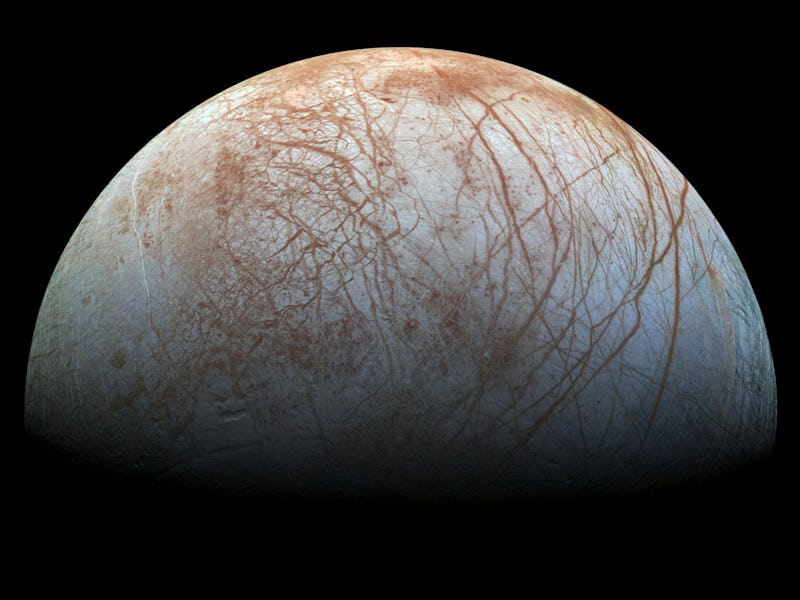Scientists Weigh Plans to Explore Jupiter's Icy Moon Europa
Will they help us find extraterrestrial life?

Jupiter’s moon Europa, the sixth-largest moon in the entire solar system, is an ice queen. Nicknamed “Jupiter II,” it has enamored scientists since its discovery by Galileo in 1610. We’ve learned a lot since then, but there’s always more we’d love to know. So scientists are convening in Paris this week to discuss a number of different proposals for new Europa missions.
They range from the feasible — like remote-sensing instruments that would orbit the moon and collect data from above — to the insane — like essentially firing burrowing sensors into Europa’s icy surface to study the moon more intimately.
(Yes, that’s a real proposal, being evaluated by real scientists.)
The European Space Agency will have the final say on what the next Europa mission will be, and it is pretty clear the group won’t consider any proposal that’s obscenely expensive. Nevertheless, these kinds of sessions often gather a ton of great ideas and allow scientists to really push discussions into far-off realms of speculation.
Whatever the ESA chooses will likely involve a probe that launches in the 2020s (hopefully no later than 2022) heading toward Europa. NASA is launching its own probe to Europa in 2022 that will make a soft landing on the surface — and it’s inviting the ESA to join in on the fun.
Europa is smaller than Earth’s own moon, but is worlds apart from the grey bugger circling our planet. Europa is made up of mostly silicate rock and retains a crust composed largely of water-ice. Underneath all that is a vast ocean of liquid water. Combined with the fact that the atmosphere has oxygen, all of these characteristics suggest that microbial life may exist on the planet.
In other words, with so much more interest in finding extraterrestrial life on other worlds, Europa is too exciting to ignore.
The researchers discussing Europa are meeting at the Observatoire de Paris on Tuesday, and delving into five broad concepts for potential missions. These include:
- A remote-sensing instrument that would accompany the NASA probe
- A free-flying satellite that would detach from the NASA probe
- A small satellite that would detach from the lander’s orbital “mothership”
- Instrument-laden projectiles that would drop from the mothership and penetrate the surface
- An instrument that would hitch a ride on the NASA lander and research the ground directly.
The projectiles are the most intriguing concept. Prior testing by pan-European aerospace company Airbus demonstrated the feasibility of firing a steel missile at a block of ice at almost 700 miles per hour and burrowing deep into the ice.
The big question is how to make sure those instruments — ranging from seismometers to miniature spectrometers — stuck to those big bullets will stay functional after the initial shock.
“One thing is true: we are very enthusiastic about proposing something, and proposing for that mission which will land on Europa for the first time in the space age,” Michel Blanc, from the Research Institute in Astrophysics and Planetology in Toulouse, told the BBC. “It’s going to be a big event, and I am sure it is going to be a big priority for the world community.”
The JUICE satellite
The ESA will be making a call about the various proposals at the end of the month. The agency already has a plan to visit Europa during the flyby of the JUpiter ICy moons Explorer (JUICE) probe while en route to the Ganymede moon. But it won’t get there till 2030. The people want to explore Europa now. Give the people what they want, ESA!